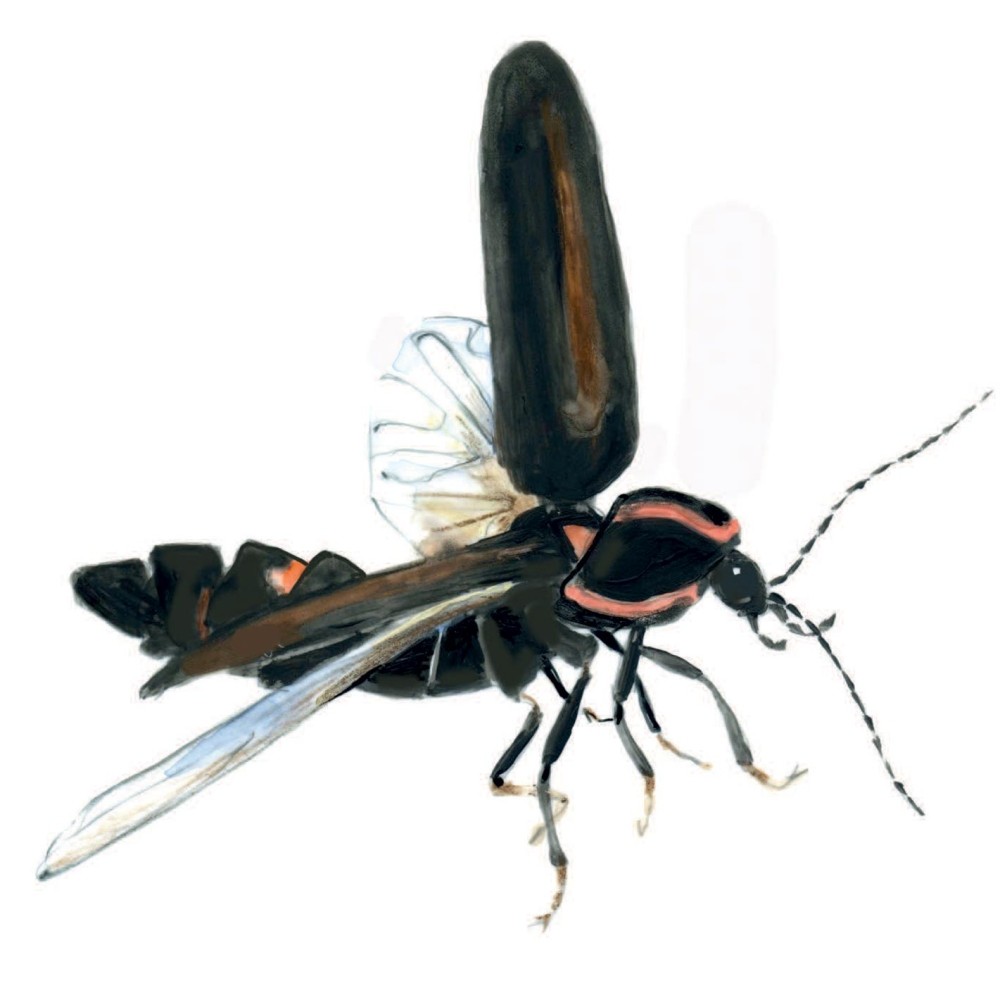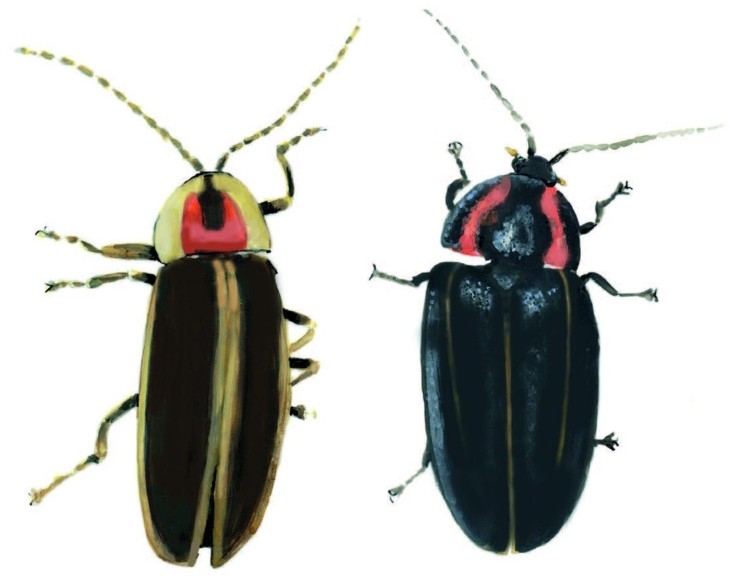
One of the year’s first insects to appear on my deck railing is the winter firefly, Photinus corrusca, which shows up on warm days throughout winter. A brown beetle with pink parentheses bracketing the segment behind its head, it closely resembles summer fireflies. But if you head out in the dark of winter evenings in search of sparks, you’ll be disappointed.
Although winter firefly eggs, larvae, and pupae glow, the adults glow only for a brief period after emerging from their pupal skin. Just as there are legless lizards and flightless birds, there are fireless fireflies that have abandoned the defining characteristic of their family (Lampyridae). And whether you think of this insect family as “fireflies” or “lightning bugs,” the common names don’t do us any favors; they are neither flies (Diptera) nor bugs (Hemiptera); in fact they are beetles (Coleoptera).
Abandoning light has consequences. Most other fireflies are night-flying (or at least the males are; in many species, the females are earthbound). Males fly about flashing their lights, and when a female likes what she sees, she responds with a welcoming signal. This nighttime singles scene spares typical fireflies from the attentions of many birds, although they remain vulnerable to bats and other nocturnal predators, including the females of some firefly species, which produce false signals to lure in meals rather than suitors.
Winter fireflies take a less flashy approach to reproduction. In 2023, Professor Sara Lower from Bucknell University discovered that female winter fireflies emit pheromones – the only known example of pheromone production by any species in this large family of beetles. The males detect females using antennae that are larger than those of nocturnal fireflies. As Lower demonstrated, the males’ antennae are also equipped with special neurons that respond to the females’ pheromones.
Because they can draw in mates without resorting to abdominal lights, winter fireflies can exploit an entirely different niche than their nocturnal cousins. The ability to find each other in daylight allows them to mate in early spring, when nighttime temperatures are still too cold for insect muscles.
Winter fireflies often appear during winter thaws. The beetles emerge from bark crevices and move about as the sun warms their dark bodies. They are fond of sweet sap flowing from freeze cracks or other tree-bark injuries, including maple taps. This attraction to sap explains why they have an additional common name: the sap-bucket beetle.
A diurnal lifestyle brings another advantage to winter fireflies. They don’t need to devote precious energy to growing large eyes, as nocturnal fireflies must do in order to detect faintly flashing lights in grass or leaf litter. Winter fireflies eyes are about half the size of those of their night-flying cousins. (Regardless of species, however, firefly eyes are always hard to see because they are hidden when we view them from above.)
Before winter fireflies are ready to crawl across a snowy tree trunk, or fall into a sap bucket, they must complete the typical beetle succession of egg, larval, and pupal stages, a process that begins in spring and takes about two years. You may find the larvae in leaf litter and rotting logs. They resemble elongated sow bugs, or armored caterpillars with brown segments pointed at the edges and flexible pink skin between. They are strict carnivores and actually good to have about the place. They eat a range of invertebrates including some garden pests such as slugs that may otherwise eat your prized black-eyed Susans or purple coneflowers.
Although they may well be the protectors of your favorite blooms, winter fireflies’ dietary habits border on the gruesome. By comparison to many large-headed predatory larvae, firefly larvae are pinheads, which enables them to access small crevices, including the narrow opening of snail shells. They pierce their prey with sharp, channeled mandibles and then inject paralytic chemicals to immobilize their meal. They also inject enzymes that reduce their prey’s tissues to a conveniently drinkable liquid form.
As is always the case with predators and prey, winter fireflies larvae are scarce as compared to the creatures they hunt. Which is why I take heart when I wander outside and find the adult beetles crawling on my sunlit deck. They won’t find much in the way of sap there, but they represent the midpoint of a healthy food web thriving right between my dormant hostas and tiger lilies.



Discussion *